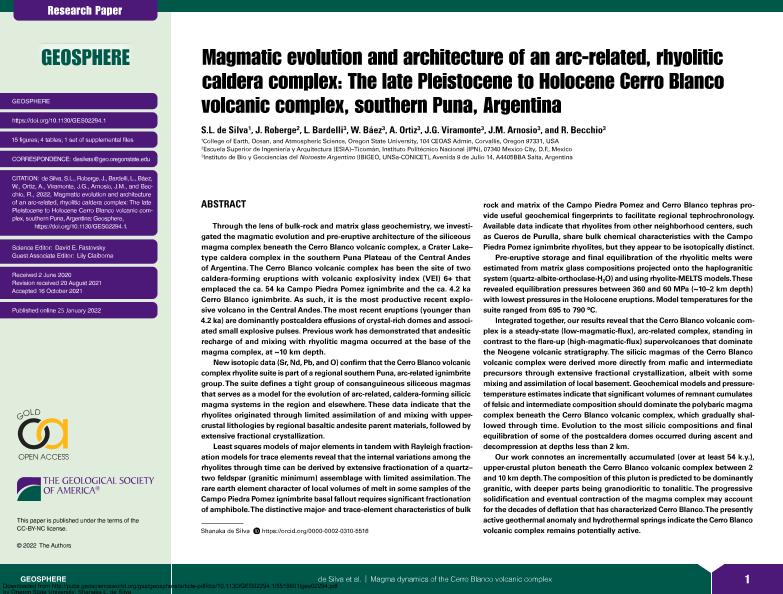Artículo
Magmatic evolution and architecture of an arc-related, rhyolitic caldera complex: The late Pleistocene to Holocene Cerro Blanco volcanic complex, southern Puna, Argentina
de Silva, Shanaka; Roberege, Julie; Bardelli, Lorenzo ; Baez, Walter Ariel
; Baez, Walter Ariel ; Ortiz Yañez, Agustín
; Ortiz Yañez, Agustín ; Viramonte, Jose German
; Viramonte, Jose German ; Arnosio, José Marcelo; Becchio, Raul Alberto
; Arnosio, José Marcelo; Becchio, Raul Alberto
 ; Baez, Walter Ariel
; Baez, Walter Ariel ; Ortiz Yañez, Agustín
; Ortiz Yañez, Agustín ; Viramonte, Jose German
; Viramonte, Jose German ; Arnosio, José Marcelo; Becchio, Raul Alberto
; Arnosio, José Marcelo; Becchio, Raul Alberto
Fecha de publicación:
01/2022
Editorial:
Geological Society of America
Revista:
Geosphere
ISSN:
1553-040X
Idioma:
Inglés
Tipo de recurso:
Artículo publicado
Clasificación temática:
Resumen
Through the lens of bulk-rock and matrix glass geochemistry, we investigated the magmatic evolution and pre-eruptive architecture of the siliceous magma complex beneath the Cerro Blanco volcanic complex, a Crater Laketype caldera complex in the southern Puna Plateau of the Central Andes of Argentina. The Cerro Blanco volcanic complex has been the site of two caldera-forming eruptions with volcanic explosivity index (VEI) 6+ that emplaced the ca. 54 ka Campo Piedra Pomez ignimbrite and the ca. 4.2 ka Cerro Blanco ignimbrite. As such, it is the most productive recent explosive volcano in the Central Andes. The most recent eruptions (younger than 4.2 ka) are dominantly postcaldera effusions of crystal-rich domes and associated small explosive pulses. Previous work has demonstrated that andesitic recharge of and mixing with rhyolitic magma occurred at the base of the magma complex, at ~10 km depth. New isotopic data (Sr, Nd, Pb, and O) confirm that the Cerro Blanco volcanic complex rhyolite suite is part of a regional southern Puna, arc-related ignimbrite group. The suite defines a tight group of consanguineous siliceous magmas that serves as a model for the evolution of arc-related, caldera-forming silicic magma systems in the region and elsewhere. These data indicate that the rhyolites originated through limited assimilation of and mixing with upper-crustal lithologies by regional basaltic andesite parent materials, followed by extensive fractional crystallization. Least squares models of major elements in tandem with Rayleigh fractionation models for trace elements reveal that the internal variations among the rhyolites through time can be derived by extensive fractionation of a quartz-two feldspar (granitic minimum) assemblage with limited assimilation. The rare earth element character of local volumes of melt in some samples of the Campo Piedra Pomez ignimbrite basal fallout requires significant fractionation of amphibole.The distinctive major- and trace-element characteristics of bulk rock and matrix of the Campo Piedra Pomez and Cerro Blanco tephras provide useful geochemical fingerprints to facilitate regional tephrochronology. Available data indicate that rhyolites from other neighborhood centers, such as Cueros de Purulla, share bulk chemical characteristics with the Campo Piedra Pomez ignimbrite rhyolites, but they appear to be isotopically distinct. Pre-eruptive storage and final equilibration of the rhyolitic melts were estimated from matrix glass compositions projected onto the haplogranitic system (quartz-albite-orthoclase-H2O) and using rhyolite-MELTS models.These revealed equilibration pressures between 360 and 60 MPa (~10-2 km depth) with lowest pressures in the Holocene eruptions. Model temperatures for the suite ranged from 695 to 790 °C ntegrated together, our results reveal that the Cerro Blanco volcanic complex is a steady-state (low-magmatic-flux), arc-related complex, standing in contrast to the flare-up (high-magmatic-flux) supervolcanoes that dominate the Neogene volcanic stratigraphy. The silicic magmas of the Cerro Blanco volcanic complex were derived more directly from mafic and intermediate precursors through extensive fractional crystallization, albeit with some mixing and assimilation of local basement. Geochemical models and pressuretemperature estimates indicate that significant volumes of remnant cumulates of felsic and intermediate composition should dominate the polybaric magma complex beneath the Cerro Blanco volcanic complex, which gradually shallowed through time. Evolution to the most silicic compositions and final equilibration of some of the postcaldera domes occurred during ascent and decompression at depths less than 2 km. Our work connotes an incrementally accumulated (over at least 54 k.y.), upper-crustal pluton beneath the Cerro Blanco volcanic complex between 2 and 10 km depth.The composition of this pluton is predicted to be dominantly granitic, with deeper parts being granodioritic to tonalitic. The progressive solidification and eventual contraction of the magma complex may account for the decades of deflation that has characterized Cerro Blanco.The presently active geothermal anomaly and hydrothermal springs indicate the Cerro Blanco volcanic complex remains potentially active.
Palabras clave:
VOLCANIC
,
GEOCHEMISTRY
,
CERRO BLANCO
,
HOLOCENE
Archivos asociados
Licencia
Identificadores
Colecciones
Articulos(CCT - SALTA-JUJUY)
Articulos de CTRO.CIENTIFICO TECNOL.CONICET - SALTA-JUJUY
Articulos de CTRO.CIENTIFICO TECNOL.CONICET - SALTA-JUJUY
Articulos(IBIGEO)
Articulos de INST.DE BIO Y GEOCIENCIAS DEL NOA
Articulos de INST.DE BIO Y GEOCIENCIAS DEL NOA
Citación
de Silva, Shanaka; Roberege, Julie; Bardelli, Lorenzo; Baez, Walter Ariel; Ortiz Yañez, Agustín; et al.; Magmatic evolution and architecture of an arc-related, rhyolitic caldera complex: The late Pleistocene to Holocene Cerro Blanco volcanic complex, southern Puna, Argentina; Geological Society of America; Geosphere; 18; 2; 1-2022; 394-423
Compartir
Altmétricas



